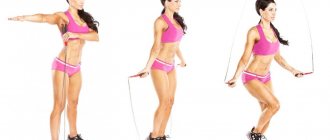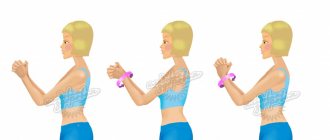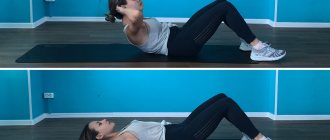Sport is very important for children ; it develops useful character traits: perseverance, determination, patience, discipline, the ability to overcome difficulties and many others. When children play sports, their energy is directed in the right direction.
In this article I will tell you how to teach a child to jump rope . This skill requires coordination, attention and endurance, and with regular practice it develops these qualities, which in turn are needed in any sport.
Before you start training, you need to choose a suitable jump rope. They come in several types, but for teaching children the best option is a beaded jump rope. She is the most obedient, allowing her to jump on all surfaces and in any weather. Beaded jump ropes are also very bright and easily visible, so children like them. The second important point is the length of the rope. To avoid making common mistakes, check out my article “How to Correctly Adjust a Rope to Your Height”
Not everyone knows an important feature: for children it is more natural to rotate their arms backwards - so you need to start with jumping with a reverse rotation of the rope.
This is easy to check: raise your hand up - it will first stretch forward, and then rise to the ceiling, but if we complete the rotation, it will turn backward.
If you want to jump with your child, then see also my article on the topic “How to jump rope correctly. Exercises for Beginners"
Jump rope is an effective exercise machine for children and adults
This projectile is suitable for girls and boys.
It can be used from 4-5 years old. In order for the learning process and the classes themselves to be comfortable, effective and safe, it is necessary to correctly approach the issue of choosing a jump rope. Its length should correspond to the height of the child. It is advisable to buy an adjustable model. You can check how well the cord fits by placing your baby exactly in the center of the projectile. When pulling the ends, they should reach the level of the armpits. No less important is the diameter. The optimal indicator is from 0.8 to 0.9 mm. The handles of the jump rope should fit easily in the athlete’s palms and not slip. To teach how to hold a projectile correctly, you need to place it in the child’s hands with a cord to the inside of the hands, which must be relaxed. The correct location is at the back on the floor. During the jump, the child must rotate the rope, turning not the whole arm, but only the hands. Legs should be slightly bent (required). If for a long period a child cannot handle the projectile correctly, you should first teach him to rotate with each hand in turn.
Advanced Jumping Techniques
To increase the intensity of training, different jumping techniques are used. There are many of them:
- jump rope running;
- jumping forward and backward;
- jumping with squats;
- with legs thrown back;
- with a rotation of 90 degrees;
- with a rotation of 180 degrees;
- jumping with squats;
- from heel to toe;
- multiple jumps;
- raising your knees high.
Below are the most popular exercises. At first glance, they will seem difficult to perform, but with daily repetition you will be able to do them without a hitch at an optimal pace. Here it is worth adhering to the principle: “Don’t push yourself through the jump, know how to relax.”
Question to the expert
Is it possible to harm yourself by using a jump rope when training?
According to osteopathic doctors, sports equipment can cause damage to the body, as it puts a high load on all muscles, skeleton and internal organs at the same time. Instead of benefit, a person can get aggravation of chronic diseases and provoke repeated fractures.
Double Jumps
During the jump, you need to have time to make two turns of the rope. Double and triple jumps use a variety of muscle groups, so they expend a lot of energy. This exercise tightens your abs. Sequencing:
- Place the jump rope behind your body.
- Initial position:
- legs are closed together, straight or slightly bent at the knees;
- the arms are close to the body, the elbows are at waist level, the wrists are bent slightly outward (not the whole arm is working, but only the hands and forearms).
- Start spinning the rope and do high jumps. Make the first jumps single, then with a long jump, quickly spin a double turn.
- Keep practicing until the first double jump on 4-5 singles becomes the norm.
Detailed video instructions about double and triple jumps on a skipping rope are below:
Jumping criss-cross
Such exercises are done to diversify training, as well as to develop manual dexterity and motor skills with coordination. Process:
- Place the rope behind your body.
- Cross your arms with a jump rope without jumping to understand the principle of action.
- Jump and swing your arms crosswise.
- Spread your arms wide and repeat the jump.
- Move quickly and increase your pace.
Detailed instructions about jumping are in the video below:
Jumping on one leg
These exercises improve coordination and increase the load on the calf muscles. Subsequence:
- The jump rope is behind you, one leg is raised off the floor.
- Throw the rope forward and jump with your foot on the floor.
- First, jump on one leg (5-10 times), then the same amount on the other.
A detailed exercise is shown in the video:
Side swing jumps
This exercise develops your shoulders and arms. How to do:
- Take the rope by the handles.
- Jump over the rope first, then swing with a folded rope.
- Swing alternately through the right and left sides.
- To make the exercise more challenging, add running during the swing.
Detailed execution of the exercise can be seen in the video:
Ali slide
The famous boxer Mohammed Ali used this technique in his training. He did the following:
- Stand in your usual stance.
- Take a jump rope and jump forward and backward while twisting the cord. It looks like light dancing movements, reminiscent of sliding on the floor.
- Move along the surface of the floor covering in different directions.
The technique builds endurance and helps the body (primarily the legs) remember light sliding movements.
The video shows how the famous boxer performed the exercise:
How to choose a jump rope according to your height
When choosing, first of all, pay attention to the size or length of the rope. A cable that is too short will hit your legs and head during exercise.
A cord that is too long will drag along the ground. All this will make training difficult, uncomfortable and even impossible. To determine how long the jump rope should be, be guided by the child’s height. The table below will help you choose a jump rope according to your height.
| Height | Jump rope length |
| Up to 150 centimeters | 180 centimeters |
| 151-167 centimeters | 2.5 meters |
| 168-175 centimeters | 2.8 meters |
| 176-183 centimeters | 3 meters |
| Over 183 centimeters | 3.5-3.8 meters |
Before purchasing, “try on” the jump rope. Let the child take the hands and step on the middle of the rope with his feet. The handles should reach your armpits. This length is suitable for the baby. When choosing a projectile, you need to take into account that even two or three extra or missing centimeters can negatively affect the safety and efficiency of jumps. Therefore, it is better to choose a model with adjustable length. They include special clamps. Such products will allow you to adjust the rope exactly according to your height.
Other selection options
In addition to growth, other criteria are also taken into account. First of all, this is the material from which the handles and cable are made. A suitable option would be a rubber cable, which is wear-resistant and has a long service life. But it shouldn't be too easy.
A nylon cord will be affordable, practical and durable. Leather cables are quite expensive and weigh more. Leather equipment is suitable for professional athletes and boxing fans.
The cheapest jump ropes include rubber handles. They are suitable for beginners, but not for long sessions. Rubber does not absorb moisture, and after just three to four minutes of training it becomes wet and slippery. Therefore, the rope will begin to slip and fall out of your hands.
A neoprene handle would be a suitable choice. It eliminates moisture in places where the material comes into contact with your hands. Therefore, even with prolonged training, the jump rope will remain dry and will not slip or fall out. Pay attention to the weight of the handle. They should not be too heavy so as not to overload the hands. The lighter the handles, the longer you can ride.
Today you can find high-speed models with a special rotation mechanism. They are the most functional and versatile, although they are more expensive. The high-speed jump rope is distinguished by light handles, high-quality materials, fast rotational abilities and the ability to adjust the length.
With a high-speed projectile, you can easily make five to six jumps per second, which is impossible with a standard jump rope. High-speed models are suitable for regular training for both beginners and those who have been jumping for a long time.
Three stages of training
Let's look at how to teach a child to jump rope. You need to understand that despite its apparent simplicity, this is far from the easiest exercise, so you should start no earlier than 4-5 years.
At the first stage, you need to teach the child to bounce on the spot
It is important to teach your child, when performing jumps, to first touch the ground with his toes when landing, and not immediately lower himself onto his entire foot. You should jump in place, without moving forward or to the side, the pace of jumping is moderately fast (about 80 jumps in one minute)
During training, you need to monitor the child’s free breathing; you cannot hold your breath. There is no need to make the baby jump high; a sufficient jump height is 10 cm.
In between exercises, you need to do several breathing exercises. It won’t hurt to periodically measure the baby’s pulse rate; the heart rate should not go beyond the normal range.
Once the jumps have been mastered, you can begin to learn how to properly rotate the rope.
First, we teach the child to correctly hold the handles of the projectile in his hands. The correct grip is loose, with the fingers of the clenched hand pointing forward.
Next, you can begin to learn the rotation technique. Most children at the learning stage try to rotate the sports equipment, making circular movements with the whole arm, that is, working with the shoulder joints. This is incorrect, it must be shown that the arms should be lowered, bent at the elbow joints, and rotation is carried out exclusively by working with the hand.
To teach how to rotate your hands correctly, at the first stage you can simply throw the rope cord over yourself without bouncing, spreading your straight arms to the side. Over time, the child himself will learn to bend his arms, because this position is more comfortable.
Then you can start jumping while simultaneously rotating the rope. This type of training is carried out like this: you need to take both handles of the apparatus in one hand and jump, rotating the folded rope on the side, making sure that the pace of jumping and the rate of rotation of the rope coincide.
Then you can proceed to the third stage, that is, learning the technique of simple jumping rope. In this case, you need to combine the first and second exercises, that is, jump in place while simultaneously rotating the rope, making sure it passes under your feet.
At the first stage, you can tie a bright bow to the center of the jump rope to make it easier for the child to follow its movements. At the beginning of the child’s learning it will be difficult, so parents will need to constantly encourage him and praise him for the slightest success.
Jump training technology
So, if you are convinced that the baby can jump on his own, and have already selected a projectile, then you can proceed directly to the training, which takes place in 3 steps.
- Step 1. Recumbent jump rope.
Goal: to teach how to jump over an obstacle and land not on your entire foot, but on your toes.
Stretch the rope on a flat surface and show your child the half-squat technique from which the jump begins. You can use multiple projectiles to create an obstacle course. Include riddles and challenges. For example: one jump - and you need to solve a riddle or recite a poem in order to jump to the next level.
- Step 2. Stop jump.
Goal: to teach how to correctly rotate the rope, connecting it with a jump.
To do this, you need to show how the hand works when rotating. It should be relaxed, and the forearm and shoulder should practically not be involved in the work. At first, the baby will be able to simply throw the jump rope over himself. When she is at his feet, he will need to make a jump, as in the previous exercise.
- Step 3. Active jumping.
Goal: increase the number of jumps, refine the technique and consolidate the skill.
At this stage, you can play together with your baby. You can spin the rope (with someone else, or by tying one end to an object), and the child will jump. Use claps or code words that will conditionally indicate the beginning of the game or count the number of jumps.
You can also jump together by organizing a mini-competition: you need to jump rope 5 times in a row. Set up rewards and punishments: the winner gets a box of juice, and the loser gets to wash the dishes. Of course, you will have to give in to the child.
Categories:
- Contacts
- User blogs (33)
- Views of pedagogy (39)
- Parenting (250)
- Activities (65)
- Diagnostics (17)
- Didactics (24)
- Computerization (19)
- Personality (71)
- Methodology (69)
- Teaching methods (69)
- Organization methods (39)
- Education (90)
- Educational articles (19)
- Training (129)
- Communication (49)
- Organization of training (32)
- Pedagogy (661)
- Pedagogical material (335)
- Prose (3)
- Training content (13)
- Creative home (18) Painting (3)
- Cinematography (4)
- Music (4)
- Poetry (3)
Sukhomlinsky School (1)
(1)
Recommendations for Beginners
Experts recommend paying special attention to some nuances
It is important to immediately explain and show the child the correct way to control the projectile, so that later he does not have to relearn:
- When performing “twisting” exercises and jumping rope, only the child’s hands need to move, and the arms themselves should be bent at the elbows. If you are not sure about the correct placement of your hands, you can watch a video of gymnasts jumping.
- When performing jumps, the body should be straightened and the gaze directed ahead.
- You need to jump, landing on the front of your foot, not on your heels.
- You should not jump too high, just lift yourself off the floor at a distance that is necessary so that the jump rope can pass under your feet.
- If it is difficult for your child to follow the movements of the projectile, you can mark its center with color - fix a piece of bright tape or colored tape there.
- After mastering the skill of jumping, you should focus your efforts on developing your baby’s endurance. A good result is continuous jumping for 10 seconds. You can invite the young athlete to jump for 15, 20, 30 seconds without mistakes or mistakes, rewarding him with praise. To interest the ward, it is advisable to choose a partner for him and let him prove which of them is more resilient.
Jumping rope is not the prerogative of girls. This activity may also appeal to a boy who, with the help of training, will be able to exercise almost all the muscles of the body, learn to breathe without delay and develop endurance.
Children are happy to work with this slightly forgotten equipment; it is only important to interest them in training and teach them how to perform the exercises correctly
When to start and what are the benefits of the exercise?
Jumping rope is a useful exercise that boxers, bodybuilders and simply people leading a healthy lifestyle include in their intensive training. Of course, it will benefit your child too.
What are the advantages of this exercise?
The heart is being trained. Metabolism improves, which is especially important if you are overweight. The muscles of the calves and ankle become stronger. Coordination and endurance are trained.
You should also remember that a jump rope can cause harm to a child if it is chosen incorrectly. Consider the following criteria when choosing a projectile.
- Length. Ask your child to stand in the middle of the rope and stretch the handles of the apparatus upward, spreading his arms to the sides. The handles should be at armpit level. The jump rope should not be longer or shorter, as the baby may get tangled in it or hit himself hard.
- Comfortable handles. If the handles are too large for the child’s palms or, conversely, small and thin, then the baby will simply feel uncomfortable, and the jump rope will constantly fall out. The same thing will happen if the material of the handles is very slippery.
- Cord and its thickness. Make sure that the cord is not tangled or too thin. If you notice that it tends to curl up, then you should not purchase such a projectile. If the diameter of the cord is excessively thick, then it will be difficult for a small child to twist the rope.
Types of exercises
The peculiarity of a child’s psyche is such that he quickly gets bored with monotonous activities, so over time, jumping rope can become boring. After mastering the basics of working with the apparatus, you can diversify the set of exercises and teach your baby new types of jumps.
A variety of jumping ropes can be a fun competition for kids
- Jump with legs forward:
- We take the rope in our hands and bring our legs together.
- We swing the cord and jump.
- We land on one leg and then lower the other.
- Jump with bent knees:
- We stand up straight and bring the rope back.
- We bring the projectile up, at the same time we jump and try to press our knees to our chest.
- Straighten your legs and return to the starting position
- Rotating the rope in the opposite direction:
- We stand straight, legs together.
- We bring the jump rope in front of us.
- We make a jump and swing the projectile behind our back.
Make sure that the hands are positioned correctly in this exercise, otherwise the child may get dislocated.
- Jump with crossed arms:
- We stand straight, legs together.
- We bring the rope back.
- We make a jump, crossing our arms with the cord.
- Before landing, the palms with the projectile must be brought to the initial position.
- Jump with crossed legs:
- We stand straight, cross our legs.
- We bring the rope back.
- We take a jump and pass the cord under our feet.
- We return to the starting position, landing on crossed legs.
- Double scrolling of the projectile:
- We stand straight, legs together.
- We swing the rope and jump.
- Before landing, you need to rotate the cord under your feet twice.
It is recommended to master the last exercise only when the child is already confident in using the apparatus and knows how to perform other types of jumps.
Video: Games that help teach a child to jump with an apparatus and diversify jumps
The best and fastest way to teach a child to jump rope is to show by example. It is easier for young children to copy an action than to understand its description. In addition, joint activities will perfectly strengthen not only your health, but also your emotional connection with your baby.
Cautions
Jumping rope is not suitable for all children. The fact is that this is quite a serious physical activity. The heart rate rises very quickly during jumping, so at the initial stage you need to monitor the child’s pulse. Exercises with a skipping rope are contraindicated for children suffering from cardiovascular diseases. Also, children who have problems with joints, etc. should not jump. If your child is overweight, you should consult your pediatrician before starting training. The doctor will determine whether he can exercise.
Parents should remember that the baby can easily get injured while jumping rope
Therefore, it is important to choose the right shoes for training. It should be light and comfortable
And he should not be allowed to jump barefoot. To prevent your child from spraining his ankle ligaments or calf muscles, it is better to perform special stretching exercises before jumping.
Thanks to jumping rope, the child will quickly improve his health and also develop coordination. In addition, with the help of a rolling pin you can quickly make friends. To make your studies more effective, you must lead by example. Not only will it be educational, but it will also help you have fun with your child. The main thing is to properly interest the baby.
Some tips for working with young children
The younger your child, the more important it is to understand the following: it will be very difficult for a child to do everything at once, and if he doesn’t succeed, then the desire will disappear, and it will be difficult to motivate him. Therefore, do not rush to move from one stage to another until you are sure that your child has reliably mastered and confidently performs the previous exercise. To help your child concentrate on training, use tricks, such as counting the number of jumps, setting intermediate goals, timer tasks, and more. I wrote in more detail about these and other points in my article “Raising a Champion”
Learning to jump
1. Select the length
Now let’s look at the technique itself: how to learn to jump rope for beginners. And first we select the length of the rope that is convenient for us. How to do it?
To do this, you need to stand with both feet in the middle of the rope. Then take the handles of the rope and pull them up vertically with both hands.
In this case, the handles of the jump rope should reach shoulder level, as in the photo.
If the handles are higher than this level, then you should shorten the rope. Because it will be heavy and uncomfortable. If it is lower, then you need to lengthen it. Because a short rope requires an accelerated pace of jumping. And this is still difficult for a beginner.
2. Getting used to the jump rope
Before you learn how to jump rope, you should get used to it, especially to its whistle nearby, so as not to be afraid
It is also important to understand the technique of rotating the rope with your hand and master it
To do this, we do the first exercise. We hold both handles of the jump rope in one hand and rotate it to the side of us.
We hold our hand at such a height that the rope hits the ground at the lowest point. We perform rotation only with a brush. First we try to rotate. Then rotate for a minute without interruption. Then we change the hand (Fig. 2). When we can easily rotate the rope for 2-3 minutes with one and the other hand, we move on to the next exercise.
3. Jumping nearby
Everything is the same as in the second point, only we add jumping to the rotation. They must be done every time you hear the characteristic impact of the rope on the ground during rotation.
What does this give? This way you develop coordination of movements.
When you jump, look straight ahead, do not try to follow the rope with your eyes. This will only throw you off your rhythm; you need to learn to “feel” the rope. Perform one minute for each side of rotation
Subsequently, you can complicate the exercise by jumping not in place, but forward or backward, or changing legs. Gradually, your arms and legs will learn to synchronize movements.
4. Individual jumping rope
Proceed to this more complex form when it is easy for you to perform the first two exercises. To do this, we start the jump rope for ourselves. This can be done in two ways. First, you can simply step over the jump rope. Secondly, swing it in a circular motion with your hands, above your head behind you.
Then extend your arms forward, holding the handles of the jump rope. The bottom of the rope will touch your shins. With a sharp movement of the arms back, we throw the rope forward over ourselves from above, accelerate it, and at the lowest point we make a low jump.
We look only forward, in front of us, and feel the moment when we need to make a jump. At first, we jump only once and again start the rope for ourselves. We do 10-20 repetitions. Then we make two rotations and jump twice, etc.
For a clearer understanding of how to learn to jump rope for beginners, you can watch this video:
What is skipping
The word “jump rope” was invented by children, because for them, first of all, it is a fun game that they can play with friends or jump alone. Kids don’t think at all about the benefits of this exercise, they just want to have fun.
This can be an advantage for parents who want to introduce their baby to this sport.
There is no need to explain to him what benefits jumping brings to the body, you just need to teach him to “play” with the cord.
Where to begin?
A suitable jump rope can be offered to a child as early as 4 years old. A suitable one is, first of all, one that is suitable in height. If you stand on the rope with both feet, holding the handles in your hands, then in a taut state it should end at the armpits. It is advisable not to buy such simple sports equipment for growth. Cut off the excess length and fasten the rope again. The handles should be comfortable, which means not too smooth so as not to slip out of your hands. The most convenient way to start serious training is with a thick rope with two knots, this is exactly the type of equipment that real gymnasts use.
From a very early age, teach your child to jump on his toes, lifting off the ground by about one and a half centimeters and without landing on his entire foot.
How to organize classes?
Particular attention should be paid to organizing activities with the baby.
Sometimes parents get excited about the idea of teaching their child something, but after a short time they give up what they started. We must try to cultivate in our offspring and ourselves the ability to bring everything to the end. We must not forget that any activity is best carried out in the form of a game. So, here are the basic principles of competent training:
You need to try to cultivate in your offspring and yourself the ability to bring everything to the end. We must not forget that any activity is best done in the form of a game. So, here are the basic principles of competent training:
- It is better to exercise with your baby in the fresh air, but you can also do this in an apartment. The main thing is not to disturb your neighbors.
- It is advisable to start teaching children simple jumping rope at the age of 4 years. Those who have not yet reached this age will find it difficult to teach even the basics.
- It is advisable to ensure that classes do not exceed 15 minutes if the student is 4-5 years old. If this is a 6-7 year old preschooler, then their optimal duration is 20-30 minutes.
- At the beginning of the workout, you need to do short gymnastics - do a few simple exercises, do a couple of squats.
- After active jumping, you should not abruptly curtail the training - let the baby calm down and catch his breath a little. To do this, you can invite him to take a few breaths, raising his hands up. A quiet game for relaxation wouldn't hurt.
- You should try to ensure that classes are held regularly - at least 2-4 times a week. Later, when the student learns to work with a jump rope on his own, he will be able to decide for himself when and where to train.
Contraindications
Although skipping is available and recommended to almost every person, there is a certain category of people who are strictly prohibited from using jump rope exercises for weight loss. Contraindications include:
- pregnancy;
- menstruation period;
- diseases of the cardiovascular system;
- migraine;
- obesity (if a person’s weight is 1.5-2 times higher than normal);
- joint problems;
- asthma;
- renal failure;
- problems with the back and spine;
- uterine prolapse.
Do not perform the program immediately after eating; about an hour must pass before you can start jumping. If during the exercise you suddenly experience pain in the knee, stomach, heart or shortness of breath, you must stop the exercise immediately. If you experience prolonged pain, it is recommended to consult a doctor (general practitioner, orthopedist, neurologist).
Read more about the benefits of this activity
Jumping rope is not only about weight loss, but also many other wonderful effects. Here is a list of just the main ones:
- the relief of your muscles (legs, hips, abs, buttocks) improves;
- the body as a whole becomes much more resilient;
- in the process of such training, a lot of calories are spent, therefore, excess weight is lost;
- A 15-minute workout burns as much as 200 calories;
- coordination of movements improves, dexterity appears;
- metabolism accelerates significantly;
- the vestibular apparatus develops;
- breathing is trained, its rhythm improves;
- the functioning of the cardiovascular system improves.
You see how many advantages there are in this activity.
How long to jump?
effective training
Start with feasible loads at a calm pace. The body adapts, and the muscles and joints have time to get stronger.
Increase the load gradually. The first week we jump for 5-10 minutes once a day or every other day, taking 30-second breaks between sets for stretching, swings, squats, bends and turns.
Every next week we add 10-15 minutes, thus bringing the duration of the workout to an hour (with 3-minute breaks for less intense exercises).
It is good to alternate jumping forward on two legs with jumping backwards and jumping alternately on each leg (2 minutes on one leg, the next approach - 2 minutes on the other).
It is best to jump to fast, energetic music.
The main exercise is jumping on two legs while twisting the rope forward. To use the maximum number of muscles, alternate different types of jumps (there are about 30 of them). On two legs; landing on each leg in turn; on one leg; jumping from side to side; with knees raised high; turning the rope forward; back; cross. In the high-impact series, don’t forget about double jumps.
A selection of outdoor games and exercises with a skipping rope
Many games with jumping rope are known to parents from their childhood. To enrich children's gaming arsenal for home use, you can offer both classic and modern outdoor games with a skipping rope and exercises.
Outdoor games
Fisherman and fish
In the game, the leader (fisherman) is selected, the rest of the players are fish. Participants stand in a semicircle. The leader is located in the center in front of the players. One end of the rope is in the hand, the other is freely located on the ground. Starts to spin in a circle. The free end must fly under the feet of the participants. They need time to jump. If the rope touches the legs, then the “fish” is caught, the player must leave the circle. Play until the last participant.
I know five names, vegetables, fruits, flowers
You can use one jump rope for everyone or each person has their own. The rules of the game are to say one word from a series of words while jumping. Vocabulary game series: “I know five names of girls, Christina once, Katya two, ... . I know five flowers, aster one, rose two...” You need to make 5 jumps for each category of objects without making a mistake in the order of words. If a player makes a mistake, the move passes to the next one.
Tens
Any number of participants can take part in the game. The game consists of ten stages. Each subsequent stage is more difficult than the previous one. If the rope hits your leg or head, it is considered a fault. The player who gets lost passes the move to the next one. You need to repeat from the place where you made a mistake. Game stages:
- jump forward ten times on two legs;
- nine times ago also;
- Jump forward on one leg eight times;
- seven ago also; - six times forward, on two legs, arms crossed;
- five jumps as well, only backwards;
- four jumps forward, alternating legs;
- three jumps as well, only backwards;
- two jumps with crossed arms forward, on one leg;
- one jump as well, but backwards.
The winner is the one who completes all stages without errors.
Salki
Such outdoor games will be interesting not only for schoolchildren, but also for older preschoolers, starting from 5-6 years old. You need to draw a large square; you cannot run outside the boundaries. Tie the jump rope in a circle. The presenter puts it on like a hoop; you have to hold it with one hand. So he must catch up with one of the participants. The caught player stands in a circle next to the leader. Now the two of them are trying to catch up with another one. And so on until the last participant.
Watch
More than three people can play, the more, the more interesting. Two players stand opposite each other. The simulator is pulled together at the level of the knees. They begin to rock him to the beat of the words “tick-tock, tick-tock.” The remaining players line up. The first participant stands near the jump rope. Jumps over it once. The next one - twice, until ten. If a player loses count, he changes place with the one who spins.
Exercises - simulators
In addition to playing with a skipping rope on the street, exercises are useful - exercise machines that can be done not only on the street, but also at home. The exercises will help you skillfully handle a sports instrument, feel it, jump in different ways, and develop flexibility. It is useful to start such activities in preschool age.
Step over the obstacle
Fold the rope in half. Take it in your hands in front of you. Step forward and backward. You need to make sure that your legs are moved alternately. Repeat 6-7 times.
Snake
The exercise can be performed while sitting on the floor. Take the end of the rope in one hand and place it on the floor with the other. Make waves as if a snake is slithering. Change hands, repeat 6-8 times.
Who is taller
To perform the action, fold the jump rope. The task is to throw it and catch it. As the child learns, the exercise becomes more difficult. For example, throw an object, then jump and catch it. Or rotate around its axis.
Watch
Do the exercise while standing. Place your legs apart, raise your arms up with the rope taut. On the count of one, lean to the right, two - straighten, three - to the left. Repeat 5-6 times. If the child already knows how to jump, then let him do this exercise. For children to be healthy, 100 jumps a day is enough.
Important! Clothes for exercise should be comfortable and shoes should be comfortable. It is not advisable to jump barefoot. Children can start training from the age of three.
How to teach a child to jump
When buying a jumping simulator, parents should help their child master it. To teach children to jump, you need to follow a certain algorithm:
- First, you should get preschoolers interested in the game. Tell an interesting story about the appearance of the jump rope. Perhaps the preschooler himself will want to buy a jump rope and choose the exercise machine he likes in the store.
- Once the instrument is selected, you can let your child play with it. Then show with your example how to use it.
- You need to teach how to twist the rope not with your whole hand, but only with your hand. First with one, then with both hands.
- Learn to step over a skipping rope. Then, rising on your toes, roll over it onto your heels.
- Next, teach jumping correctly. Be sure to make sure that the child lowers himself onto his toes, then with his entire foot. Knees are bent.
- You need to jump on a mat; a hard floor can harm your feet. A carpet that is too thick will not work either.
The baby will definitely want to jump on his own if he masters the basic movements. You need to try to teach in a fun way so as not to discourage them. When teaching, do not rush your preschooler, master all the movements gradually.
Tips for parents
- The jump rope is a very compact exercise machine and is inexpensive. You can take it for a walk, on a trip, or on a picnic. It's easy to entertain a child if parents are busy.
- You can start practicing with a skipping rope in middle preschool age, from the age of four, when the baby has already mastered the basic movements and the muscles of the arms and legs are sufficiently developed.
- This simulator is not only suitable for girls, boys can play too. But modern boys prefer other games, considering jumping rope to be fun for girls. However, this is not only a toy, it is also a trainer for muscles and heart. If you explain the importance of this item, it will be useful to use it for the physical development of boys. For them, you can choose jump ropes in blue and green colors. And for girls - brighter or multi-colored.
- Be sure to choose a jump rope that is suitable in length. Shorter for one child, so that it is comfortable to jump. If several children are jumping at the same time, the length of the rope should be longer.
Important! Children with diseases of the spine, joints and heart are prohibited from jumping rope. They can make the situation worse. At the same time, outdoor games are necessary for children, especially outdoors. You can come up with calm exercises with a jump rope, since by playing with this useful exercise machine, the child will improve his health.
How to jump rope correctly in more complex ways?
There should be no problems with other methods of performing jumps, since they are performed according to the same principle. Let us dwell only on high jumps and the “one-legged” technique of performing exercises. High jumps are all the same methods listed earlier in the article, however, during the exercise, you need to raise your knees high. With the help of such jumps, you can easily put problem areas in order: during high jumps, your abs are worked out, which allows you to get rid of excess fat deposits in this area much faster and more effectively.
It is important to pay significant attention to proper breathing when training. By breathing rhythmically through your nose, it will be easier for you to perform jumps, and the effect will be more pronounced.
A few more general recommendations on how to learn to jump rope:
A few more general recommendations on how to learn to jump rope:
- You should not start your workout too abruptly: it is better to start with a light warm-up, and then perform the exercises at a slow pace. Only when you feel that the muscles are ready for training and are sufficiently warmed up, you can speed up the pace;
- Select sports equipment by size (that is, in accordance with your height);
- You should not immediately start with long training sessions; it is better to limit the first sessions to 5-7 minutes;
- Land on your toes softly, otherwise you may get injured;
- When you master different types of jumps, you can combine them with each other. This way the training will be more fruitful and interesting.
We’ve figured out how to jump rope correctly, now let’s move on to advanced jumping techniques.
Rules that must be followed
- A straight posture is required when jumping (you cannot lower your head). Breathing is done only through the nose.
- Land on your toes (with light springing) to soften the load on the spine and leg joints. Therefore, the knees are kept bent while jumping.
- Only the hands rotate, the shoulder and forearm remain in the selected position.
- The projectile does not fall to the floor during a jump, but only touches it (only in this case, when rebounding from the floor, the projectile will not hit the legs).
- It is advisable to monitor the height of the jump, which should not exceed five centimeters from the floor.
conclusions
Skipping is a simple, effective way to keep your body in good shape. It includes a variety of exercises aimed at strengthening muscles, normalizing the functioning of the heart and blood vessels, breathing, and losing weight. It’s easy to learn how to jump rope, just follow these simple recommendations:
- you should start with simple, basic movements;
- before jumping at a high pace, you should prepare and warm up your muscles and joints;
- you should increase the intensity and complicate the exercises gradually;
- you need to remember to breathe correctly, monitor your pulse rate, combine jumping with rest;
- To lose weight, you should exercise regularly and adhere to a balanced diet.
With the right approach and regular training, skipping will bring you real pleasure.
Not only will you feel better and lose weight, but you will also surprise your friends with new tricks. Date: January 8, 2022
Losing excess weight
The set of exercises with a skipping rope needs to be expanded: this will allow the body to avoid getting used to a certain load and work out different muscle groups. Regular exercises contribute to rapid weight loss by burning a layer of subcutaneous fat, increasing muscle mass, strengthening the corset, training coordination and the vestibular apparatus.
To lose 1 g of subcutaneous fat, you need to burn 9 kcal. Therefore, to get rid of 1 kg of fat you need to burn 9000 Kcal. As we noted above, one hour of skipping allows you to burn from 500 to 1500 Kcal. Taking into account all the factors: dietary habits, lifestyle, nature of work, we can conclude how many times you need to jump rope to have an effect.
For a stable weight loss of 1 kg per week, you need to perform one or two regular workouts lasting at least one hour. For faster weight loss, skipping must be alternated with strength elements. To increase definition, skipping is combined with various types of training aimed at working individual muscle groups.
Regarding the question of when it is better to jump rope in the morning or evening, there is no unanimous opinion. The main thing is that the training is regular and takes place at the same time. For some, morning workouts are suitable - in combination with gymnastics, this will help warm up the muscles and get a boost of energy for the whole day.
Some prefer the period of time between lunch and afternoon snack: during this period, the muscles are quite warmed up, and sleep is still far away. Still others choose the evening - after work, active exercise allows you to get rid of negative emotions received during the day, reduce the effects of stress, and relieve tension.
Weight loss program for beginners
- Intensity of classes: 2 times a week.
- Training time: start with 20 minutes, gradually increase to 1 hour.
- Efficiency: up to 3-5 kg in 1 month.
First lesson program
| Type of training element | Duration of exercise | Rest after element |
| In place, basic | half a minute | 30 seconds |
| Scissors | 60 seconds | half a minute |
| Reverse scissors | 60 seconds | 30 seconds |
| With body rotated 90 degrees | 60 seconds | half a minute |
| With a swing of the left leg | 30 seconds | half a minute |
| With a swing of the right leg | 30 seconds | half a minute |
| Combined simple elements (alternating simple exercises) | 1.5 minutes | 60/***30 seconds |
| ***Jumping in place | 30 seconds | hitch |
| REPEAT SEQUENCE | ||
| TOTAL: 10 minutes. | ||
Second lesson program
| Type of training element | Duration of exercise | Rest after element |
| In place, basic | half a minute | 15 seconds |
| Double Jumps | 60 seconds | 15 seconds |
| Running in place | 60 seconds | half a minute |
| on the right leg | 60 seconds | 30 seconds |
| on the left leg | 60 seconds | half a minute |
| Jumping with a 90 degree body turn | 60 seconds | 30 seconds |
| Squat Jumps | 1.5 minutes | half a minute |
| ***Jumping in place | 30 seconds | hitch |
| REPEAT SEQUENCE | ||
| TOTAL: 10 minutes. | ||
Weight loss program for experienced
- Intensity of classes: 2 times a week.
- Duration of training : 1 hour.
- Efficiency: up to 3-5 kg in 1 month.
The program consists of several blocks that must be alternated.
Lesson program
| Blocks | Type of training element | Exercise time | Rest after element |
| №1 | In place, basic | 60 seconds | 15 seconds |
| On the left leg | 60 seconds | 15 seconds | |
| On the right leg | 60 seconds | 15 seconds | |
| Running in place | 60 seconds | 15 seconds | |
| TOTAL: 5 minutes. Number of repetitions: 2. | |||
| №2 | Scissors | 1.5 minutes | 45 seconds |
| Reverse scissors | 1.5 minutes | 45 seconds | |
| Boxer (right-left) | 2 minutes | 45 seconds | |
| Boxer (back and forth) | 2 minutes | 45 seconds | |
| TOTAL: 10 minutes. Number of repetitions: 2. | |||
| №3 | Exercise with body rotation 90 degrees | 1.5 minutes | 45 seconds |
| With a right swing | 1.5 minutes | 45 seconds | |
| With a left swing | 2 minutes | 45 seconds | |
| Combined jumps (alternating simple exercises) | 2 minutes | 45 seconds | |
| TOTAL: 10 minutes. Number of repetitions: 2. | |||
| №4 | Cross jumps | 2.5 minutes | 45 seconds |
| Jumping back and forth | 2.5 minutes | 45 seconds | |
| Cross Jump | 2.5 minutes | 60 seconds | |
| TOTAL: 10 minutes. Number of repetitions: 1. | |||
| №5 | ***Jumping in place | 30 seconds | hitch |
| TOTAL: 60 minutes. | |||
With systematic training, you can and should try new, more complex elements and include them in a systematic training program.










